Cuba offers spectacular off-the-beaten-path opportunities, from stunning natural beaches and landscapes to colonial cities with fascinating culture and traditions. Being one of the least explored destinations in Latin America, the island is not short of a surprise for budget backpackers. Backpacking Cuba can certainly fill you with memories of epic adventures.
In this article, you will learn everything about backpacking in Cuba!
Backpacking Cuba Activities
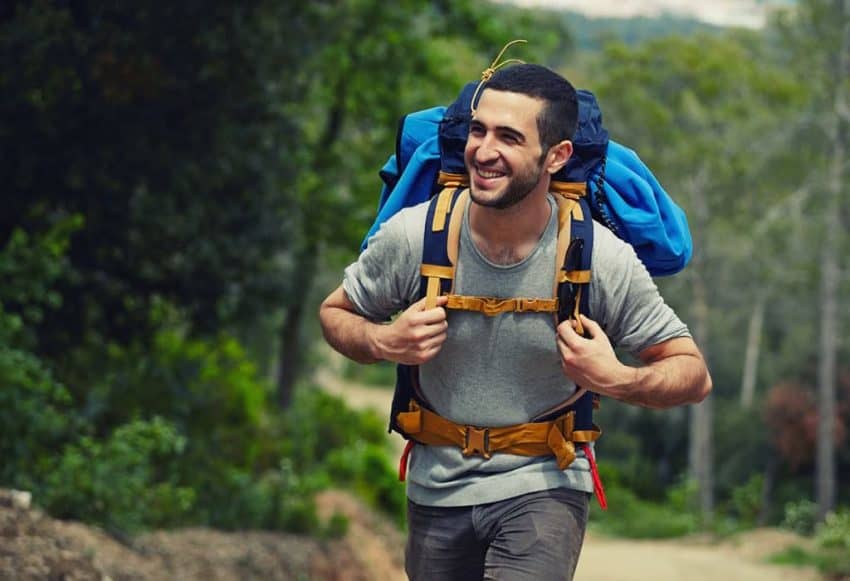
Wild camping in Cuba
Outside of Cuba’s large cities are miles and miles of wilderness and smaller villages waiting to be explored. If you choose to bring a tent, you can set it up in a location of your choice.
Be aware that although many locations are safe to camp on, private landowners might not appreciate you pitching a tent on their property. If you’re unsure, it’s better to ask so you don’t run into an awkward situation.
Keep in mind that camping at higher elevations is more comfortable than sleeping in the lowlands or near the coast. Cuba is hot, humid, and filled with mosquitos. Higher elevation areas like the Sierra Maestra mountains offer cooler air, breezes, and fewer insects than the lowlands.
And wherever you choose to camp, follow the “leave no trace principles” by cleaning up after yourself and leaving no trash behind!
Horse riding in Cuba
Horseback riding is a viral activity for tourists in Cuba, especially as you leave the lights of the cities behind and venture deeper into the countryside. Horse riding is also affordable, starting at 5 USD/hour.
Remember that the season you travel during may affect horseback riding; Cuba experiences heavy rainfall during the rainy season, so tours may have limited hours during that time.
You can ride horses in many parts of Cuba, but the Viñales national park has the best. Trinidad is a close second, thanks to its beaches, waterfalls, and unbeatable views in Valle de Los Ingenios.
Rock climbing in Cuba
Cuba’s landscape features beautiful, unique rock formations that create a genuinely memorable rock climbing experience.
You can find Cuba’s best rock climbing at the legendary Viñales national park, a World Heritage Site located in the mountainous western province of Pinar del Rio. Viñales’ combination of high-grade limestone, accessibility, and stunning views secures Cuba’s designation as the best Caribbean country for rock climbing.
Hiking in Cuba
Hiking in Cuba was once heavily restricted, but the government recently opened the scenic countryside to hikers and adventurers. Until recently, visitors weren’t allowed into nature reserves and national parks, but all that has changed in recent years.
However, guides are still necessary for most areas, except for Viñales. Many trails are still quite rugged, so expect a challenging infrastructure with natural trails and few signs or information.
Adventurers will enjoy the challenge of the Sierra Maestra mountain range, which boasts the highest peaks on the island, in addition to its historical legacy during the Cuban Revolution. The best place to access the mountains is at Turquino national park near Santiago de Cuba.
Bird watching in Cuba
As the largest nation in the West Indies, Cuba is home to over 372 species of birds, 26 of which can only be found in Cuba.
The variety of bird species can be attributed to Cuba’s many habitats, ranging from tropical to wetlands and forests. Cuba’s bird-watching hotspots include La Güira national park, the Las Terrazas eco-tourism reserve, and the biosphere reserve at Ciénaga de Zapata.
Scuba diving in Cuba
Cuba is a scuba diver’s paradise. Due to its history, Cuba is less developed than neighboring islands and has many pristine scuba diving spots to explore.
Cuba’s fishing industry is not as intense as other islands in the Caribbean, so you’ll encounter many more native fish species in their natural habitats. Cuba’s untouched reefs are truly dazzling!
Here are the top 6 scuba diving spots in Cuba:
- Diving in Maria la Gorda
- Dive Along Punta Frances: Cuba’s Fabled Pirate Coast
- Jardines de la Reina Marine Park
- Scuba Diving in Cayo Largo
- Jardines del Rey and Cayo Coco
- Bahía de Cochinos (Yes, that Bay of Pigs)
Cycling in Cuba
Biking is a great way to experience Cuba since taking taxis can add up.
Visitors to Cuba use bikes for both transportation and entertainment. For example, cruising around Havana on a bike can help you cover the ground faster than walking. But it also gives you an excellent opportunity to check out many of the sites in the city. If you prefer guided activities, you can also join a bike tour group like these offered by Tour Republic.
Sancti Spiritus is a small town that doesn’t get much tourist traffic but is the starting point of a beautiful bike trail that heads toward Trinidad. It puts you in the shadow of the Sierra del Escambray mountains.
Holguin balances grassy hills and idyllic fields with stunning beaches. Highlights include the port town of Gibara and the beaches at Guardalavaca.
Backpacking Itineraries for Cuba (From Havana)
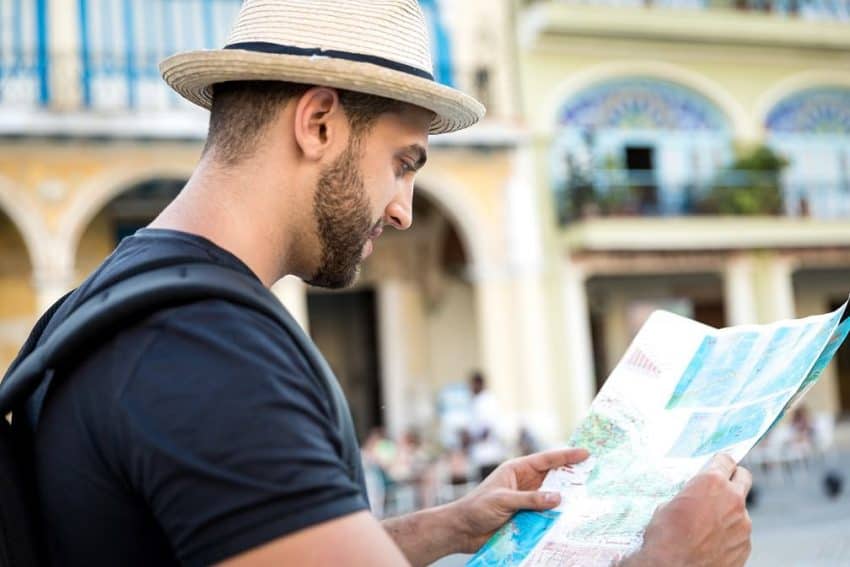
Weekend itinerary in Cuba
With just a weekend in Cuba, Havana has plenty to explore. Since you only have 48 hours, be sure to focus on quality over quantity!
Places to visit during a weekend in Havana:
- Parque Central y El Capitolio
- Habana Vieja and surroundings (Plaza Vieja, Convento de San Francisco de Asís, Plaza de Armas, Catedral de La Habana)
- El Malecón
- Ceremonia del Cañonazo en la Fortaleza de San Carlos de La Cabaña
- Plaza de la Revolución
- Museo de Bellas Artes (Fine Arts Museum)
- Fusterlandia
- Explore the nightlife: Fábrica de Arte Cubano
1-week itinerary in Cuba
If you have a whole week in Cuba, you can get a taste of Havana in addition to having enough time to explore nearby areas of interest like Viñales and Trinidad.
Havana -> Viñales -> Trinidad
1) Havana:
- Cherry-pick your favorites among the above places or our top 22 things to do in Havana.
2) Vinales:
- Horseback riding
- Tobacco farm tour
- Hiking or mountain climbing in the limestone mountains
3) Trinidad:
- Waterfall hikes
- Playa Ancón for beach time!
2-week itinerary in Cuba
A full 14 days in Cuba means you have enough time to explore cities, beaches, and mountains.
After completing the activities mentioned in the 1-week itinerary, you’ll strike out to see Cienfuegos and Parque Nacional Ciénaga de Zapata.
Havana -> Viñales -> Trinidad -> Cienfuegos -> Parque Nacional Ciénaga de Zapata
4) Cienfuegos:
- Castillo de Jagua
- Teatro Tomás Terry
- Cementerio La Reina
5) Parque Nacional Ciénaga de Zapata
- Hire a guide and some horses to immerse yourself in this legendary park.
3-week itinerary in Cuba
Three weeks in Cuba is enough time to explore a vast portion of the entire country.
Havana -> Viñales -> Trinidad -> Cienfuegos -> Parque Nacional Ciénaga de Zapata -> Bay of Pigs -> Rancho Luna -> Santa Clara -> Santiago de Cuba
6) Bay of Pigs:
- Playa Máquina
- Snorkeling at Cueva de los Peces
- Península de Zapata (National Park)
- Criadero De Cocodrilos (Croc farm)
7) Rancho Luna:
- Rancho Luna beach
- Guanaroca lagoon
8) Santa Clara:
- Parque Leoncio Vidal
- Teatro La Caridad
- Catedral de Santa Clara de Asís
- Mausoleo del Che Guevara
- Fábrica de Tabacos Constantino Pérez Carrodegua
9) Santiago de Cuba:
- Castillo de San Pedro de la Roca
- Parque Céspedes
- Cementerio de Santa Ifigenia
- Plaza de la Revolución
- Day trips to La Gran Piedra and Basílica de Nuestra Señora de la Caridad del Cobre
Transportation Options
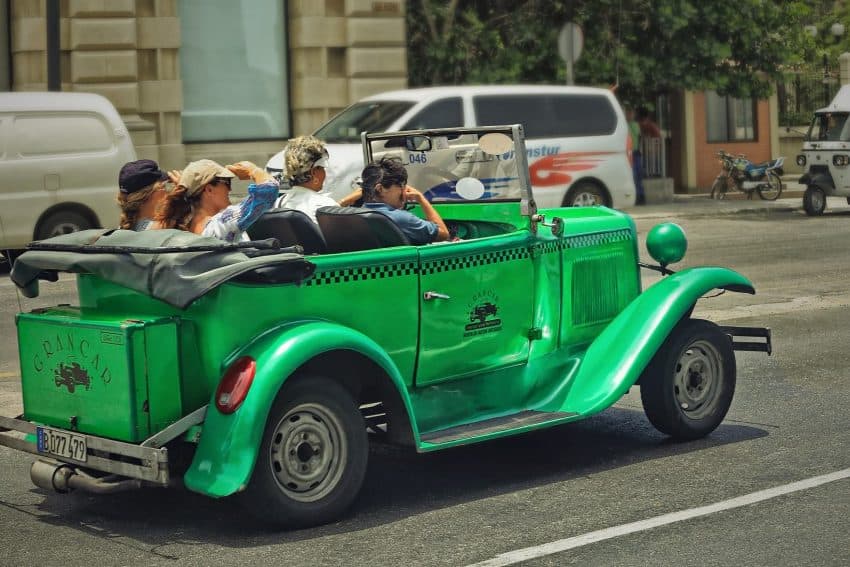
State taxis (short rides)
Cuba’s state taxis are official taxis owned and operated by the Cuban government.
You’ll notice that there’s a difference in quality among state taxis. “Newer” state taxis are typically Asian imports and have modern amenities like air conditioning in addition to providing smoother rides. Old model taxis are older Russian imports without the advantages of modern vehicles.
While both old and new taxis will get you to your destination, newer model taxis may charge a bit more.
Taxis charge 1.50-3 USD/kilopmeter.
Private taxis or almendrones (short rides)
Cuba’s private taxis, also known as almendrones, are owned and operated by private taxi drivers. They’re the colorful vintage American cars you see cruising up and down the streets, which is one of the most interesting facts about Cuba.
Although many almendrones typically follow a fixed route, you can hire a driver to take you anywhere in the city. Rates usually fall anywhere between 10-20 USD.
Buses (intercity rides)
Viazul buses are a simple, affordable way to get around in Cuba. You should get your ticket well in advance through Viazul’s website. Please, print your receipt and arrive at least an hour before departure! Check out our step-by-step guide to booking a Viazul bus in Cuba.
Domestic flights
Domestic flights may be your best option if your trip includes traveling long distances within Cuba, like from Havana Airport to Santiago de Cuba.
Most flights connect to large cities like Havana or Santiago de Cuba. However, you can still reach smaller cities by plane, like Baracoa Bayamo, Guantanamo, and Nueva Gerona.
Ticket prices can cost from 90 USD on the low end to 140 USD on the higher end. You can compare prices and book tickets here.
Trains
Trains are also an option for getting around Cuba, but they’re not as reliable as buses or domestic flights.
Passengers report widespread delays due to fuel shortages, aging trains, and old infrastructure. If you’re not in a hurry to be in a particular place on time, then trains are still scenic and affordable, but most are really in bad shape.
If you choose to travel by train, consider that you must pay for tickets in cash and that most trains (even overnight trains) don’t provide meals or snacks. Check train timetables here.
Hitchhiking in Cuba
Hitchhiking is a popular way to travel around Cuba (for locals). Low crime rates and low vehicle ownership have created a thriving hitchhiking scene. Hitchhiking is so common that you can find “amarillos” (traffic controllers) organizing hitchhiking in large cities like Havana.
Hitchhiking in Cuba is legal and relatively safe, as long as you follow your common sense. Rides typically cost 2-20 USD, depending on how far you need to travel.
Renting a Car in Cuba
Renting a Car in Cuba is the most expensive option. Not only are they expensive (they start at 69 USD/day), but they could be impossible to get in advance.
Daily Budget
Generally, you should expect to spend 50 – 120 USD/day, excluding flight tickets. Below are the most common costs in Cuba:
Accommodation – On average, most people pay between 20 to 50 USD a night in a “casa particular” or Airbnb in Cuba. Most city hotels start at 50 USD/night, while resorts can go as high as 800 USD/night. For availability, check out Skyscanner.
Transportation – As discussed earlier, transportation costs vary according to the means of transportation you use:
- Taxis start at 1 USD/kilometer.
- “Almendrones” will charge 10-20 USD for a short ride.
- Tickets for inter-municipal Viazul buses range from 6 to 51 USD.
- Long haul private transfers start at 120+ USD.
- Train tickets cost 3-7 USD.
- Don’t expect hitchhiking to be free. Some drives can cost up to 20 USD.
Food – homemade breakfast costs around 5-12 USD, while a meal at a sit-down restaurant is anywhere from 10 to 20 USD.
Drinks – A 1.50 liter bottled water costs 3 USD, coffee can be as high as 1.50 USD, and most alcoholic drinks are between 3-7 USD.
Internet – using a Nauta Card, expect to pay 0.50 USD/hour.
For a full breakdown, check out our travel budget for Cuba and our tipping guide for Cuba.
The Packing Checklist for Backpacking Cuba
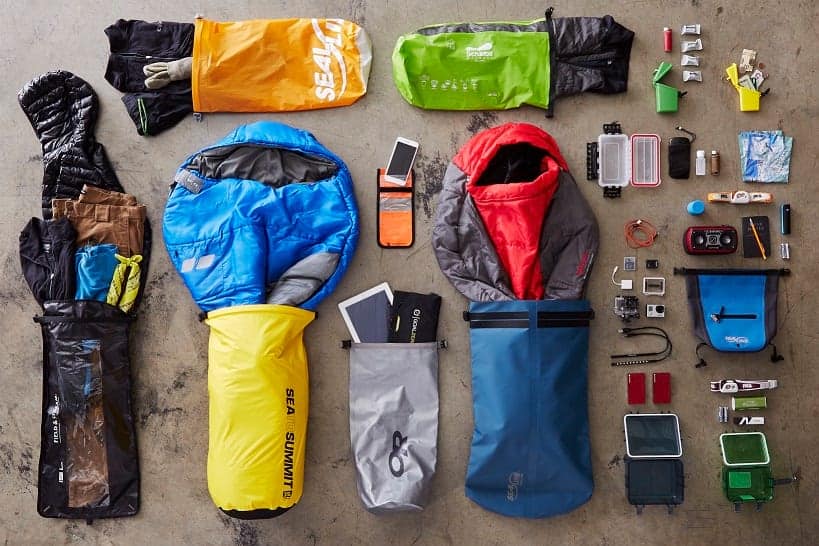
Like any other backpacking trip, you have to stay organized and prepared. Here are some essential items that should be part of your backpacking checklist to Cuba:
- Backpacking tent
- Backpack
- Sleeping bag & sleeping pad
- Backpacking food
- First aid kit
- Water filter
- Sunscreen
- Insect repellant
- Other personal items, accessories, and appropriate clothes (check our ultimate packing list to Cuba)
Additionally, you should consider installing some offline apps that will make your days easier in Cuba. This is especially important because you can’t rely on Internet connectivity in Cuba. Here are a few useful offline apps for your backpacking Cuba adventure:
- Google Maps: You’ve almost certainly used (or at least heard of) Google Maps before. But did you know you could use the GPS tool offline? Just download the offline version of the app, and you can use it to navigate Cuba without WiFi!
- A La Mesa: Cuba’s version of Yelp! Check out menus and reviews for local paladares.
- Kindle: The Kindle app lets you access books, audiobooks, magazines, and even games. Perfect for your day at any of the best beaches in Cuba!
- Audible: Audible is an app just for audiobooks. Using their offline app, you can download a few audiobooks ahead of time and listen to them as your backpack around the country.
- Amazon Music: Cuba is a country that loves music, so your Cuba trip wouldn’t be complete without a playlist. Amazon Music’s offline app lets you put together the perfect Cuba playlist and listen to it (offline!) during your trip.
- AccuWeather: Cuba has good weather year-round, but you may encounter lots of rain and humidity depending on when you travel. Let AccuWeather keep you updated on the latest weather reports in Cuba.
Practical Tips for Backpacking Cuba

Get travel health insurance
All visitors to Cuba are required to have travel medical insurance. We recommend you get it from Insubuy, the cheapest and most convenient provider. Beyond simply fulfilling a requirement, travel insurance also keeps you covered in case of a medical emergency, injury, or illness.
Don’t rely on the Internet
In today’s high-tech world, people are used to having internet everywhere they go. Cuba is a different story.
Cuba technically has internet, but Cuban internet can be challenging to access, limited to specific locations, slow, and expensive. Expect to rely on old-fashioned paper maps, travel guides, Spanish phrasebooks, and word of mouth from trustworthy locals. Check out our Cuban internet guide to learn more!
Don’t drink tap water
Avoid drinking tap water during your stay in Cuba.
Like almost any other foreign country, Cuba’s drinking water is home to its native bacteria and microorganisms. A visitor’s stomach won’t be attuned to the native bacteria and could become ill from drinking the water.
Tap water from upscale resorts might be alright, but don’t try your luck at a small cafeteria. Instead, stick to bottled water or pack a bottle with a built-in filter.
Protect against mosquitoes
Cuba is known for its hot, humid, damp weather. This type of weather, while great for swimming and adventuring, also leads to heavy insect activity.
Mosquitoes and flies are common across the island. They can be vectors for diseases like malaria, dengue fever, and the Zika virus. Bring a powerful insect repellant with you to avoid eating alive by insects.
Also, try to visit Cuba in the dry season, when humidity is lower and there are fewer bugs and mosquitoes. However, costs can be higher during this popular time to visit Cuba.
Keep your luggage locked
You’ll probably leave your luggage in your room at a hotel or casa familiar during your stay in Cuba. While Cuba’s crime levels are low compared to other countries in the Caribbean, thefts still can and do occur from time to time.
To avoid returning to your room to discover your belongings have been picked over, secure your bag with a TSA lock.
Be aware of currency scams and pickpockets
Cuba’s crime rates are low, and some of the most common crimes (especially those that target tourists) are scams and pickpockets.
Scams often involve tricking tourists with the confusing Cuban currency system. Double-check to ensure you receive the correct currency when purchasing anything in Cuba. The CUP is the only currency in Cuba, and the CUC was just eliminated!
Avoid slums
Like all countries, Cuba has its nice areas and its not-so-nice areas.
Slums can be dangerous, especially for tourists, since you can fall victim to crimes more easily than in nicer, better-policed areas.
Slums are most common in large urban cities like Havana. If you visit Havana, avoid rough neighborhoods like Guanabacoa, Centro Habana, and Marianao.
If you find yourself in a bad situation, a handy travel whistle can summon help!
Share your trip with trusted locals or reputable guides
Cuba is filled with guided tours and excursions, but only some are legitimate. Only hire guides through reputable tour groups and travel agencies to avoid scamming.
Learn some Spanish
Cuba is a Spanish-speaking country, so you should expect to have many opportunities to speak some Spanish of your own. Plus, Cubans appreciate it when visitors try to speak the local language.
You don’t need to be fluent in Spanish to navigate Cuba. Instead, you can pick up a Spanish-English phrasebook and dictionary to guide you.
If traveling from the US, stick to private
Can Americans travel to Cuba? Yes, they can, mainly through the Support for the Cuban People license. But they are subject to additional travel restrictions, including prohibiting spending money at certain state facilities. To be safe, stick to private services when possible.
Are Your Bags Packed Yet?
Backpacking Cuba is a simple, safe, and affordable way to get around the island. All you have to do is pack up your essentials, and you’re ready to explore Cuba’s many cities, national parks, beaches, and more.
Are you planning a backpacking trip to Cuba? Let us know in the comments!
Essential Travel Logistics For Cuba
Cuban Tourist Card – If your Cuban Tourist Card (a.k.a Cuban Tourist Visa) isn’t bundled into your airline ticket or travel package, buy it only through EasyTouristCard.
Travel Health Insurance – Travel medical insurance is an entry requirement for Cuba, so you can’t skip it. Travelers can get travel health insurance for Cuba via Insubuy. Travel protection benefits such as trip interruption and cancellation, baggage delay insurance, etc., are not required.
Essential Items to Pack – Bring the essential travel necessities that you may not be able to get in Cuba:
- First aid kit
- Hand sanitizer
- Face masks
- Water bottle with filter
- Sunscreen
- Mosquito repellent
- Pin adapter (for Europeans)
- Travel guide
- Spanish-English phrasebook
- Suggested Reading: The Cubans: Ordinary Lives in Extraordinary Times
Read our complete packing list for Cuba.
Find Accommodations – Find hotels or casas particulares (private accommodations) on Skyscanner, which lists thousands of accommodations available in Cuba.
Book Your Flight – Book cheap flights to Cuba on Skyscanner, our favorite flight search engine to find deals on flights to Cuba.

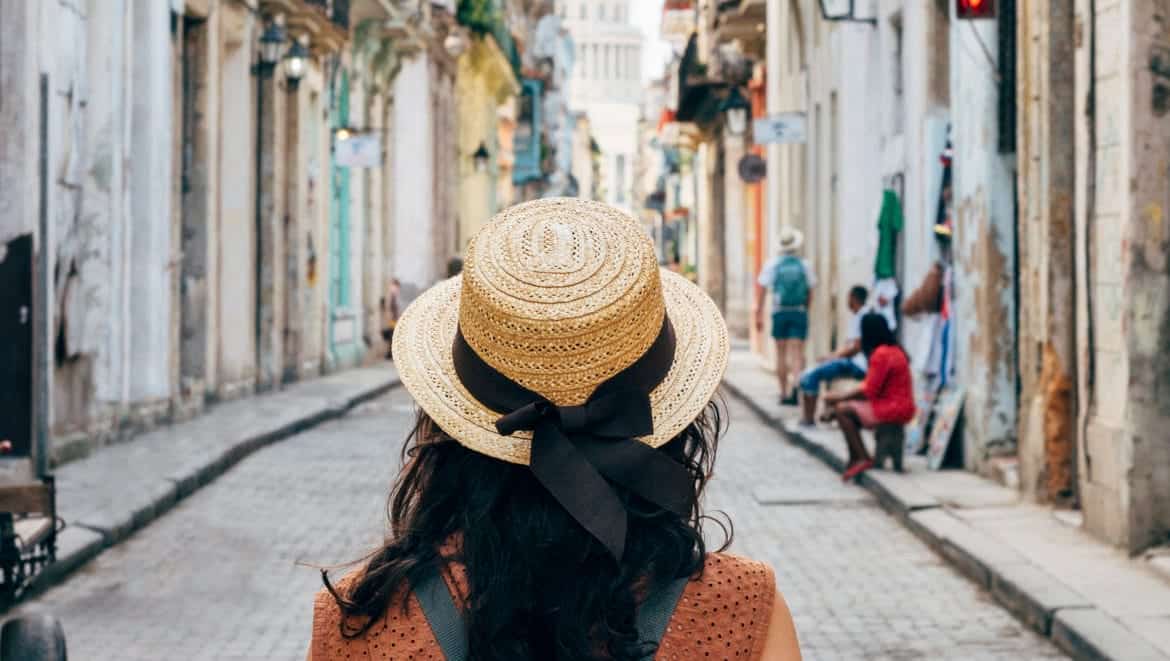

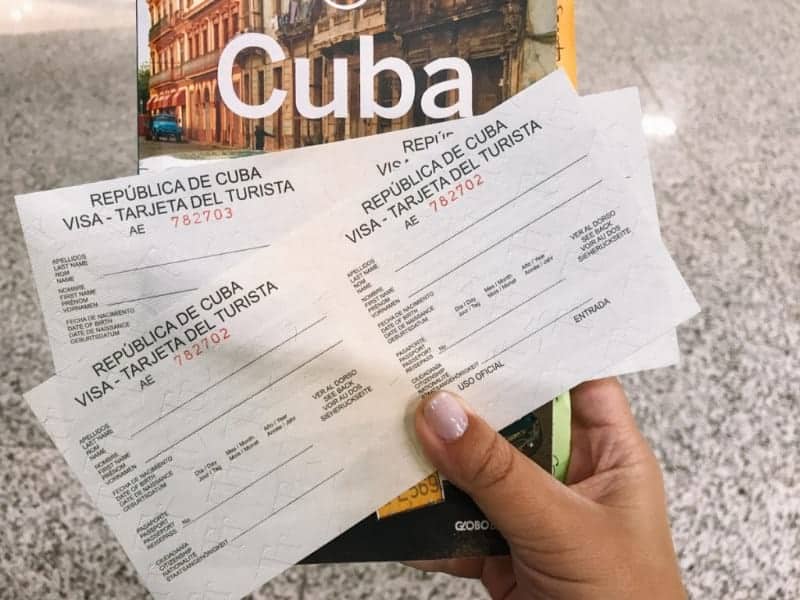
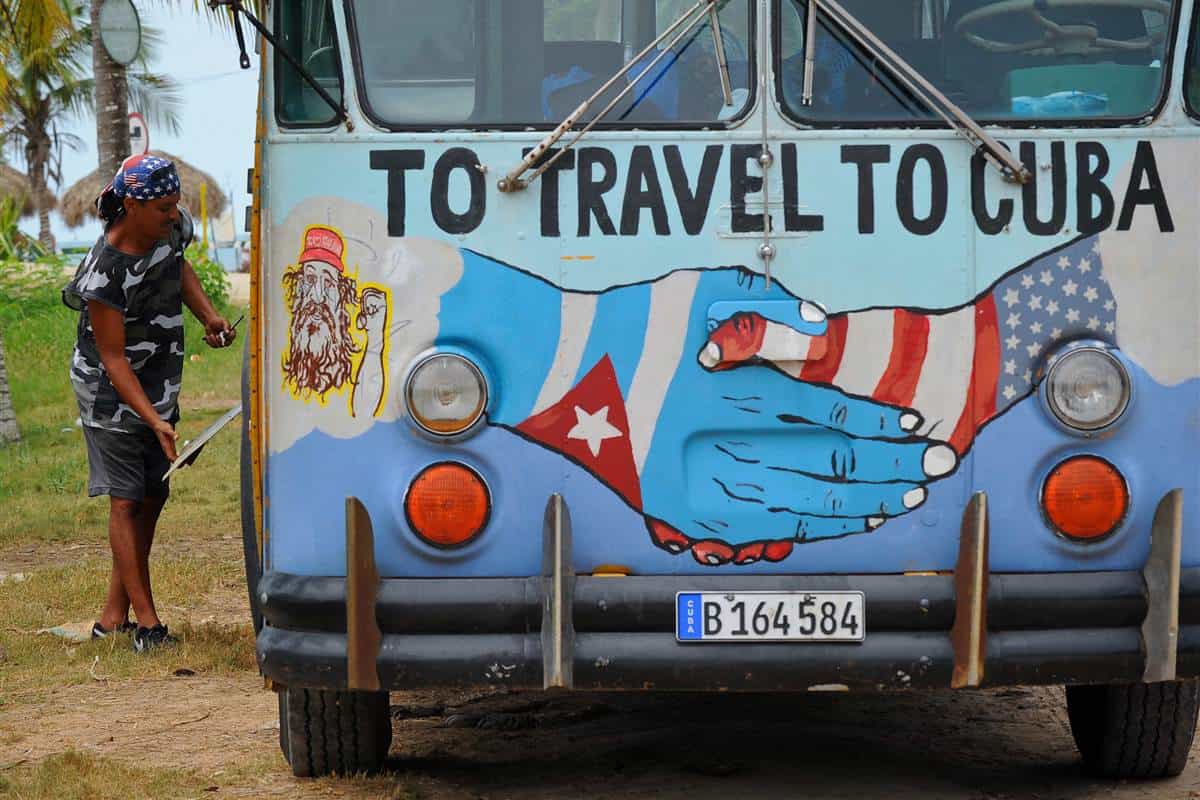
Neat article.
One question: why have you left out so many modes of transport? For a backpacker, money is usually an issue and it strikes me as odd that you’ve omitted some of the cheaper options.
In Havana:
Shared taxi (colectivo/machina). This mode of transport is where price meets comfort in Havanas transportation system. 50 pesos for a daytime ride between municipalities and 100 pesos in the evening/night. Sure, you need to know some basic routes but again, this is part of the fun. And as always in Cuba, you can ask just about anhyone for help.
La guagua (bus). Sure, it’s crowded, especially in the afternoon. Still, since all tourists these days go on and on about “authenticity” (whatever that means) then they should give it a go. Just paying the two pesos and getting on is an adventure.
Between municipalities:
El Camión. By far the cheapest option for long-distance traveling. The journey from Havana to Santiago set you back 2 000 pesos (paid in cash after you board) as of May 2022. Compare that with 5 500 (51 UDS) for the Viazúl. Also, it’s much faster and you get to share the ride with Cubans.
Shared taxis: can be organized from a casa or by people haning out at the local bus station (most likely you’ll be approached as you’re out ewalking as well). Sheaper than a private taxi and takes you door to door.
local buses. For shorter distances between cities there’s usually a bus that’ll cost you next to nothing. Ask around.
Regarding the train section:
Update it, the info is outdated. Cuba got new trains three years ago and the system works a lot better these days. Tickets are bought a month (!) in advance at the ticket office. You can also show up three hours before departure and grab a ticket for a no-show. And obv, there are agencies that sell tickets at a markup as well.
Thanks for the great information about traveling to/in Cuba. We would love to go diving at Jardines de la Reina and maybe one additional site for a couple of days in addition to just exploring the country’s food, music and culture. What is the best way to get there, what should we expect, do we need a guide, are there dive operators to rent gear from? Is diving a justifiable reason to “support the Cuban people”?